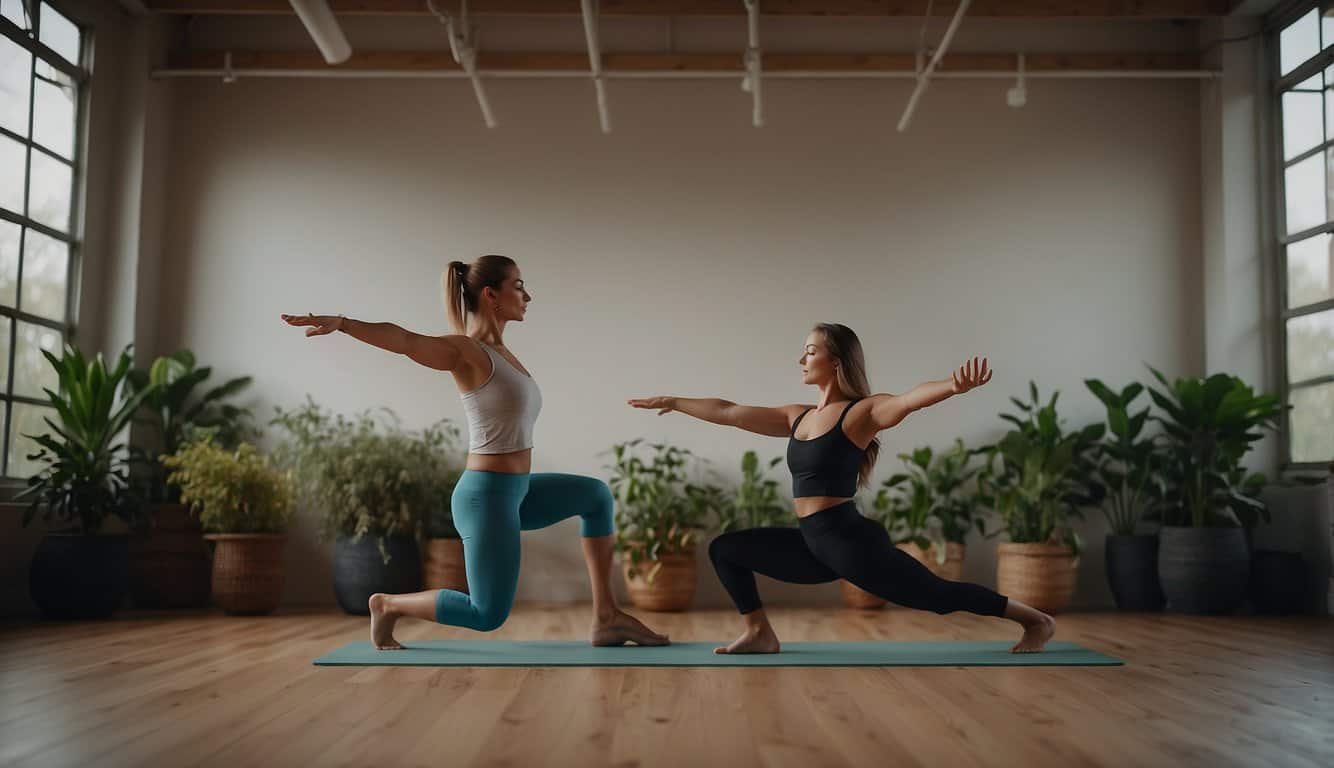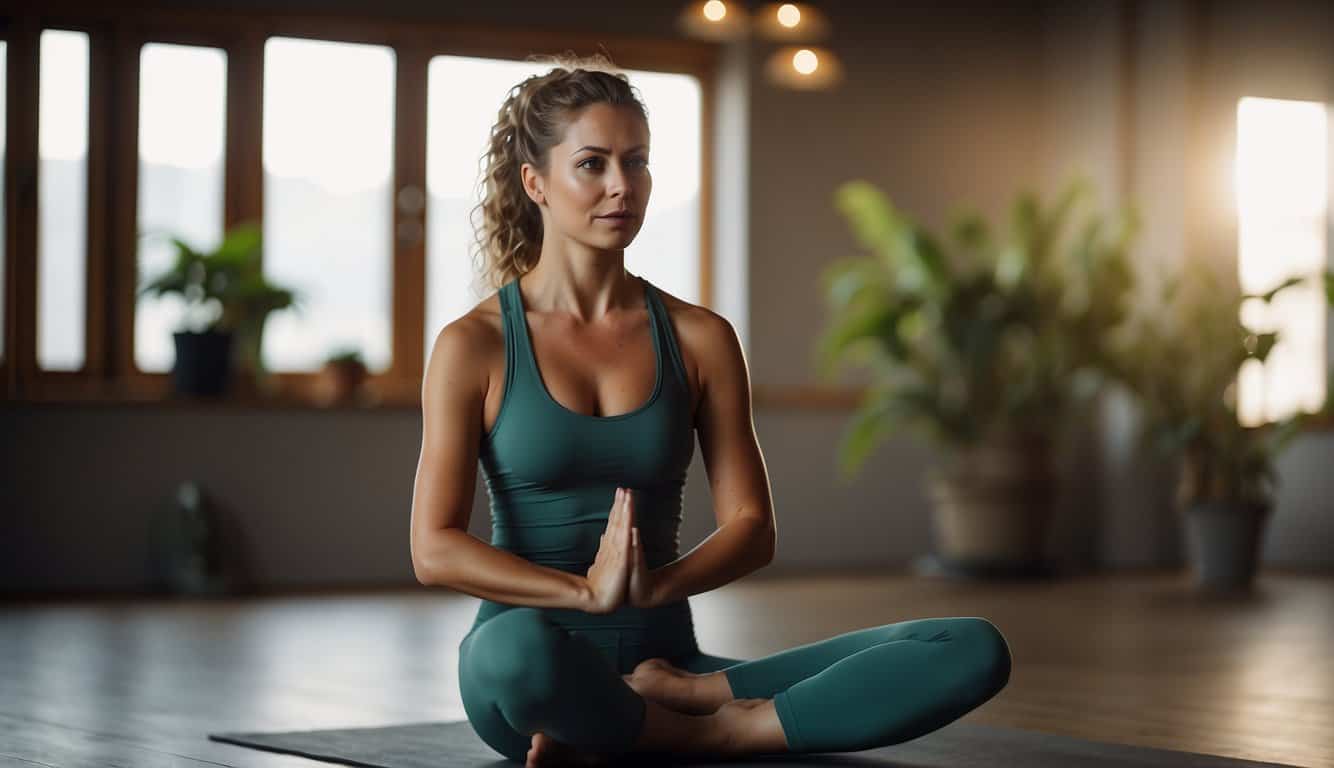Discovering the distinct styles of yoga can be an exciting journey into the traditions and innovations within the practice.
Two popular forms that often cause curiosity are power yoga and vinyasa yoga. While they share common roots in the yoga tradition, these two styles have branched into unique practices with different focal points.
Power yoga is known for its fitness-driven approach, often appealing to those looking to enhance their strength and stamina. It is characterized by its fast pace and the holding of poses for longer periods to build muscle and concentrate on the physical aspect of the practice.

Conversely, vinyasa yoga, sometimes called “flow” yoga, emphasizes the seamless transition between poses, connecting movement and breath. This style is often considered more rhythmic and meditative, offering a dynamic practice that promotes flexibility and mindfulness.
Vinyasa flows are typically more varied and less predictable than the structured sequence of power yoga, allowing for creativity and adaptation to the practitioner’s needs.
Explore the complete differences between power yoga vs vinyasa yoga below.
Key Takeaways
- Power yoga emphasizes strength, and longer pose holds, while vinyasa yoga focuses on flexibility and fluid movements.
- Vinyasa connects breath with motion, offering a meditative flow that can be adapted to individual needs.
- Both styles originate from traditional yoga but differ in practice, offering unique physical and mental benefits.
Origins and Philosophies

Exploring the beginnings and underlying principles of both Power and Vinyasa Yoga uncovers their unique histories and philosophical underpinnings, shaped by influential teachers and ancient texts.
Roots of Power Yoga
Power Yoga, a term popular in the West during the late 20th century, is often credited to practitioners like Beryl Bender Birch and Bryan Kest.
It is fundamentally inspired by Ashtanga Yoga, a rigorous and structured form of yoga developed by Sri Tirumala Krishnamacharya and later popularized by his student, Pattabhi Jois.
Krishnamacharya, often called the father of modern yoga, played a pivotal role in reviving Hatha Yoga through a dynamic sequence of postures (asanas) and breathing techniques (pranayama).
Power Yoga distances itself from the strict sequence in Ashtanga Yoga, offering a more accessible practice focusing on flexibility and strength. Its philosophy encourages personal exploration and freedom within the practice, emphasizing the physical aspects of yoga to cater to Western sensibilities.
Foundations of Vinyasa Yoga
Vinyasa Yoga is intimately connected to the flowing nature of Sanskrit chants and the concept of synchronizing breath with movement.
The term “Vinyasa” can be translated from Sanskrit to mean “to place in a special way,” which refers to the careful choreography of yoga poses transitioning smoothly from one to another.
This style also has roots in Ashtanga Yoga, drawing on its dynamic transitions. However, unlike Ashtanga, which offers a fixed series, it offers a variety of sequences.
Vinyasa Yoga is known for its creative sequencing. It caters to those who appreciate a diversity of movements and a continuous flow that cultivates balance, focus, and aligned movement. The philosophy of Vinyasa values adaptability and intuitive motion, often mirroring the rhythms and changes of life itself.
Key Characteristics
A few distinguishing factors set them apart when discussing Power Yoga and Vinyasa Yoga. Each style has unique attributes that cater to different preferences and goals in one’s yoga practice.
The Role of Breath in Vinyasa
In Vinyasa Yoga, your breath is synchronized with your movement. It’s an essential component guiding the transition between asanas (poses). The fluidity of a Vinyasa flow arises from this harmony, creating a dance-like progression through postures.
Strength and Posture in Power Yoga
Power Yoga emphasizes strength and form. It involves holding poses longer, which challenges your muscles and enhances endurance. While it shares certain movements with Vinyasa, the focus on maintaining posture under strain is crucial to its practice.
Common Poses and Sequences
Vinyasa Yoga often incorporates Sun Salutations as a warm-up, leading to rapidly changing asanas. In contrast, Power Yoga sequences might have fewer poses but involve longer holds, offering a different intensity and focus.
The common ground lies in the fundamental asanas present in both styles.
Physical and Mental Benefits

When you practice Power or Vinyasa Yoga, you enhance your physique and nurture your mental health. These practices have numerous benefits that affect different areas of your well-being.
Flexibility and Balance
Regular Power Yoga or Vinyasa Yoga practice makes your muscles more supple, and your joints move more freely. This increased flexibility aids your balance, improves your posture, and leads to better bone strength through low-impact weight-bearing poses.
The dynamic movements in Vinyasa encourage the body to develop a wider range of motion, while the sustained poses in Power Yoga enhance stability.
Mental Concentration and Stress Reduction
Yoga encourages you to focus, and this mental concentration carries over to daily life, improving your ability to remain present and attentive.
Stress reduction is another key benefit, with deep breathing and mindfulness playing a central role. The enhanced oxygen uptake boosts your respiratory system, while the improved blood circulation benefits your cardiovascular health.
Engaging in these forms of yoga promotes endurance, not just physically as your muscles work and adapt, but also mentally as you learn to sustain focus under pressure.
Practical Considerations

When deciding between yoga styles, consider your fitness goals, energy levels, and personal preferences to find the best fit for your lifestyle.
Choosing the Right Style for Your Needs
Power Yoga might be your match if you’re eyeing a style that enhances strength and includes a vigorous workout. It focuses on fewer poses with longer holds, boosting muscle endurance.
Conversely, Vinyasa Yoga could be ideal if a dynamic, flowing sequence that connects movement with breath appeals to you. It’s less strenuous than Power Yoga but can still improve flexibility and bring about a sense of calm.
Weigh factors like the intensity of the workout, the potential for injury, and whether the practice complements other activities you enjoy.
- Power Yoga can serve as an excellent cross-training practice for those who frequent the gym and want to integrate yoga into their routine, offering deep stretches and recovery for the body.
- Considering energy levels, if you need a more meditative, calming experience, Vinyasa may help balance your energy flow.
Tips for Beginners
Starting a new yoga practice requires careful consideration to ensure a beneficial and sustainable journey.
- Look for beginner-friendly classes emphasizing proper form, alignment, and breath control.
- Talking to a yoga teacher can provide insight into what to expect from each style and help tailor the practice to your body‘s needs.
- Invest in a good-quality yoga mat with grip and cushioning to support your practice.
- A solid time commitment is necessary, so choose a style that fits seamlessly into your routine and consider the locations of yoga studios or online options for convenience.
- Be mindful of any injury or physical limitation and select a style that minimizes the risk of exacerbation.
Embracing the nuances of each style will guide you to the right choice, ensuring a fulfilling and enriching yoga experience.
